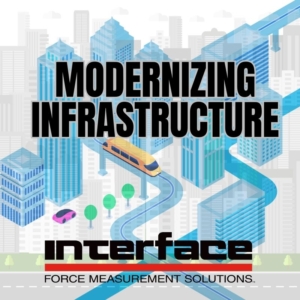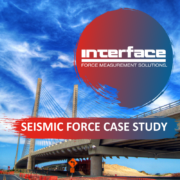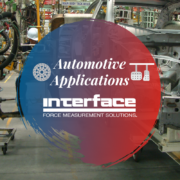Modernizing Infrastructure with Interface Sensor Technologies
 Modernizing infrastructure is a major priority for governments and companies around the world, and significant investments are being made to support this effort. Force measurement solutions are a critical component of modern infrastructure, helping to ensure safety, optimize performance, and improve efficiency. Interface load cells, torque transducers, load pins, tension links and other wireless solutions are used in projects all over the world that are modernizing our global infrastructure in a variety of ways.
Modernizing infrastructure is a major priority for governments and companies around the world, and significant investments are being made to support this effort. Force measurement solutions are a critical component of modern infrastructure, helping to ensure safety, optimize performance, and improve efficiency. Interface load cells, torque transducers, load pins, tension links and other wireless solutions are used in projects all over the world that are modernizing our global infrastructure in a variety of ways.
The McKinsey Global Institute estimates that global infrastructure investment could reach $79 trillion by 2030, with China accounting for the largest share of that investment. These estimates are based on a range of factors, including population growth, urbanization, and the need for infrastructure upgrades and maintenance.
There is also a heavy emphasis in utilizing sensor technologies for “smart” infrastructure. This includes building smart cities, smart buildings, smart grids, smart highways and intelligent transportation systems. Read more about how infrastructure related companies, suppliers and civil engineers use our sensors in Infrastructure Projects Rely on Interface,
Intelligent Transportation Solutions for In-Motion Train Track Monitoring
Pillow block load cells are valuable in building and enhancing infrastructure. When our PBLC1 is installed on a track, and the train runs across it, the sensor can provide a signal to a station elsewhere in the world. If any force indicators suggest that there could be a problem with the weight the train is holding or the train itself, the sensor can also trigger an automatic shutdown of the train.
Trains are not new; however, how we can use sensor technologies to keep passengers and cargo is growing in demands. These sensors could prevent major damage from train derailments and other train related incidents by detecting errors before the inflict damage. This type of sensor is a great solution for monitoring trains on a track, in-motion.
How are Interface sensor technologies in modernization projects?
Structural testing: Force measurement solutions are used to test the strength and durability of structures such as bridges, buildings, and dams. Sensors can be attached to the structure and used to measure the forces acting on it, such as wind, vibration, or seismic activity. This information can then be used to identify areas that may be weak or prone to failure, allowing for necessary repairs or upgrades. Read more in our Bridge Seismic Force Monitoring Solution App Note.
Monitoring machinery: Force measurement solutions can also be used to monitor the performance of machinery and equipment. Sensors can be installed to measure the forces generated by the machinery, such as torque or pressure, and this data can be used to identify potential problems before they cause equipment failure or downtime. This is exemplified in our Crane Capacity Verification App Note.
Material testing: Force measurement solutions are also used to test the strength and durability of materials such as metals, plastics, and composites used in modernizing infrastructure. Sensors can be used to measure the forces required to break or deform the material, providing valuable data for material selection and design. Read Interface Solutions for Material Testing Engineers.
Geotechnical engineering: Force measurement solutions can be used to monitor the forces acting on soil and rock formations, which is important for the design and construction of structures such as tunnels, mines, and retaining walls. Sensors can be installed to measure factors such as pressure, stress, and strain, which can be used to ensure the safety and stability of these structures.
As sensor technologies continue to advance, we can expect to see even more innovative projects in the future.
ADDITIONAL RESOURCES
Interface And Infrastructure Markets Form A Perfect Partnership
Innovative Load Pin Applications








